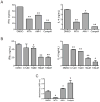Effects of a novel arginine methyltransferase inhibitor on T-helper cell cytokine production
- PMID: 20345902
- PMCID: PMC2903848
- DOI: 10.1111/j.1742-4658.2010.07623.x
Effects of a novel arginine methyltransferase inhibitor on T-helper cell cytokine production
Abstract
The protein arginine methyltransferase (PRMT) family of enzymes catalyzes the transfer of methyl groups from S-adenosylmethionine to the guanidino nitrogen atom of peptidylarginine to form monomethylarginine or dimethylarginine. We created several less polar analogs of the specific PRMT inhibitor arginine methylation inhibitor-1, and one such compound was found to have improved PRMT inhibitory activity over the parent molecule. The newly identified PRMT inhibitor modulated T-helper-cell function and thus may serve as a lead for further inhibitors useful for the treatment of immune-mediated disease.
Figures






Similar articles
-
Arginine methylation of NIP45 modulates cytokine gene expression in effector T lymphocytes.Mol Cell. 2004 Aug 27;15(4):559-71. doi: 10.1016/j.molcel.2004.06.042. Mol Cell. 2004. PMID: 15327772
-
The Development of Tetrazole Derivatives as Protein Arginine Methyltransferase I (PRMT I) Inhibitors.Int J Mol Sci. 2019 Aug 6;20(15):3840. doi: 10.3390/ijms20153840. Int J Mol Sci. 2019. PMID: 31390828 Free PMC article.
-
Discovery of a Potent Class I Protein Arginine Methyltransferase Fragment Inhibitor.J Med Chem. 2016 Feb 11;59(3):1176-83. doi: 10.1021/acs.jmedchem.5b01772. Epub 2016 Jan 29. J Med Chem. 2016. PMID: 26824386
-
Mechanisms and Inhibitors of Histone Arginine Methylation.Chem Rec. 2018 Dec;18(12):1792-1807. doi: 10.1002/tcr.201800082. Epub 2018 Sep 19. Chem Rec. 2018. PMID: 30230223 Free PMC article. Review.
-
Chemical probes for protein arginine methyltransferases.Methods. 2020 Mar 15;175:30-43. doi: 10.1016/j.ymeth.2019.11.017. Epub 2019 Dec 3. Methods. 2020. PMID: 31809836 Review.
Cited by
-
Integrated Network Pharmacology and Metabolomics Analysis of the Therapeutic Effects of Zi Dian Fang on Immune Thrombocytopenic Purpura.Front Pharmacol. 2018 Jun 19;9:597. doi: 10.3389/fphar.2018.00597. eCollection 2018. Front Pharmacol. 2018. PMID: 29971001 Free PMC article.
-
Structure-Based Discovery of Inhibitors of the SARS-CoV-2 Nsp14 N7-Methyltransferase.J Med Chem. 2023 Jun 22;66(12):7785-7803. doi: 10.1021/acs.jmedchem.2c02120. Epub 2023 Jun 9. J Med Chem. 2023. PMID: 37294077 Free PMC article.
-
Current chemical biology approaches to interrogate protein methyltransferases.ACS Chem Biol. 2012 Mar 16;7(3):443-63. doi: 10.1021/cb200519y. Epub 2012 Feb 1. ACS Chem Biol. 2012. PMID: 22220966 Free PMC article. Review.
-
Targeting Aberrant Epigenetic Networks Mediated by PRMT1 and KDM4C in Acute Myeloid Leukemia.Cancer Cell. 2016 Jan 11;29(1):32-48. doi: 10.1016/j.ccell.2015.12.007. Cancer Cell. 2016. PMID: 26766589 Free PMC article.
-
Coactivator-associated arginine methyltransferase 1 regulates fetal hematopoiesis and thymocyte development.J Immunol. 2013 Jan 15;190(2):597-604. doi: 10.4049/jimmunol.1102513. Epub 2012 Dec 17. J Immunol. 2013. PMID: 23248263 Free PMC article.
References
-
- Lin WJ, Gary JD, Yang MC, Clarke S, Herschman HR. The mammalian immediate-early TIS21 protein and the leukemia-associated BTG1 protein interact with a protein-arginine N-methyltransferase. J Biol Chem. 1996;271:15034–15044. - PubMed
-
- Bedford MT, Richard S. Arginine methylation an emerging regulator of protein function. Mol Cell. 2005;18:263–272. - PubMed
-
- Krause CD, Yang ZH, Kim YS, Lee JH, Cook JR, Pestka S. Protein arginine methyltransferases: Evolution and assessment of their pharmacological and therapeutic potential. Pharmacol Ther. 2007;113:50–87. - PubMed
-
- Lee DY, Ianculescu I, Purcell D, Zhang X, Cheng X, Stallcup MR. Surface-scanning mutational analysis of protein arginine methyltransferase 1: roles of specific amino acids in methyltransferase substrate specificity, oligomerization, and coactivator function. Mol Endocrinol. 2007;21:1381–1393. - PMC - PubMed
Publication types
MeSH terms
Substances
Grants and funding
LinkOut - more resources
Full Text Sources
Other Literature Sources
Molecular Biology Databases

